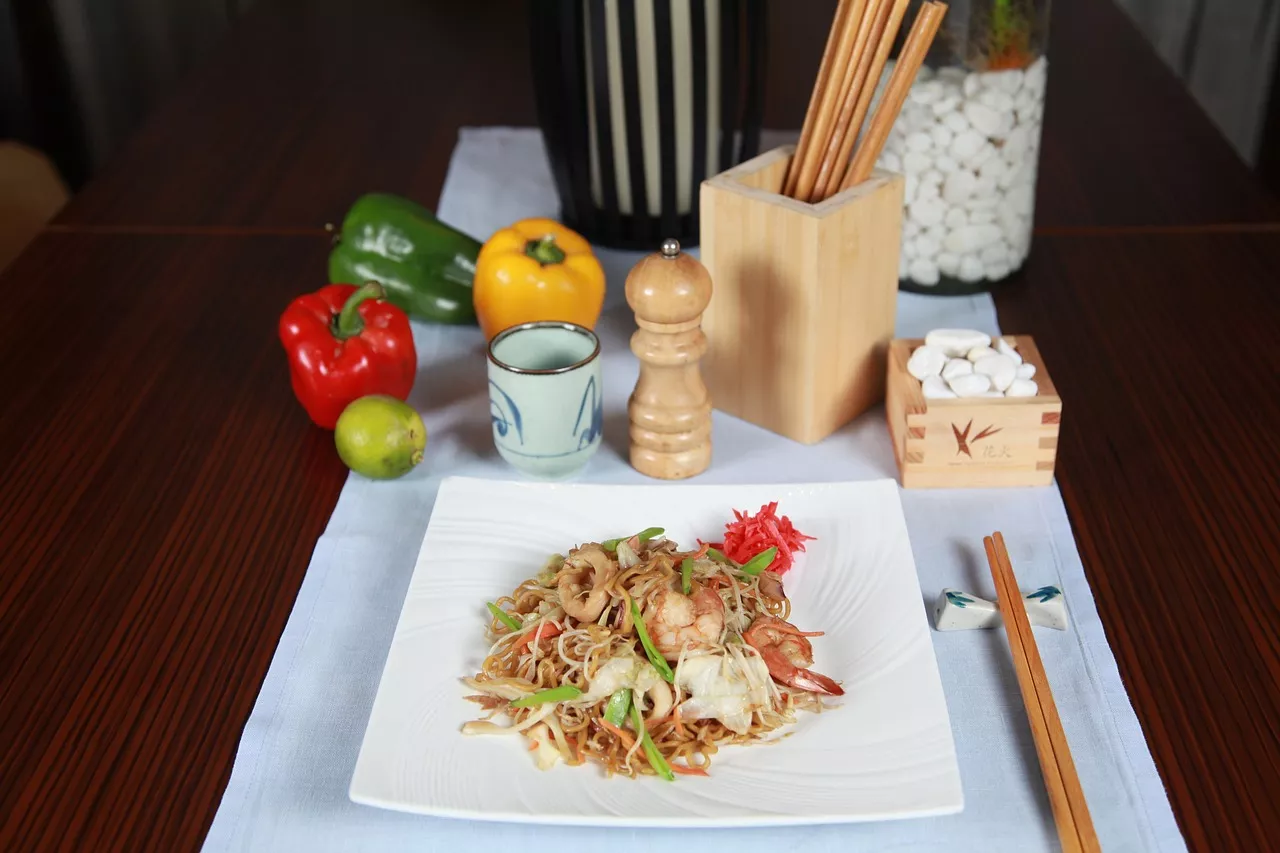Introduction
Step into a world of culinary wonders as we take you on a gastronomic journey through Thailand's delightful cuisine. From the iconic Pad Thai to the aromatic Tom Yum, Thai food is renowned for its bold flavors and unique blend of ingredients. With a harmonious combination of sweet, sour, salty, and spicy flavors, every dish tantalizes your taste buds and leaves you craving for more.br/>
Indulge in the vibrant street food culture of Thailand, where food vendors whip up delectable dishes right before your eyes. Sample the crispy goodness of chicken satay, the fiery kick of green curry, and the refreshing sweetness of mango sticky rice. Each bite brings you closer to the heart and soul of this incredible country.br/>
But Thai cuisine is more than just a feast for the senses. It reflects the rich cultural heritage of the Thai people, with influences from neighboring countries like China, India, and Malaysia. From the bustling markets of Bangkok to the tranquil rice fields of the north, Thai food tells a story of tradition, pride, and exceptional craftsmanship.br/>
So join us as we embark on a culinary adventure through the diverse flavors and mouthwatering dishes that make Thai cuisine truly unforgettable. Get ready to savor the essence of Thailand, one bite at a time.br/>
Popular Thai Dishes
Thai cuisine offers a wide array of dishes that have gained popularity around the world. From the comforting flavors of Pad Thai to the aromatic delight of Tom Yum, these dishes have become staples in Thai restaurants worldwide. Pad Thai, a stir-fried noodle dish with a perfect balance of sweet, sour, and salty flavors, is a favorite among locals and tourists alike. It features rice noodles, shrimp or chicken, bean sprouts, tofu, and crushed peanuts, all tossed in a tangy tamarind sauce.
Another crowd-pleaser is Tom Yum, a spicy and sour soup that exemplifies the bold flavors of Thai cuisine. Made with lemongrass, kaffir lime leaves, galangal, and Thai chili peppers, this aromatic soup is usually prepared with shrimp or chicken. The combination of tangy lime juice, fish sauce, and fragrant herbs creates a symphony of flavors that is both refreshing and invigorating.
In addition to these classics, Thai cuisine offers a wide variety of other mouthwatering dishes. Green curry, red curry, and massaman curry are all beloved dishes that showcase the rich and complex flavors of Thai spices. Each curry is made with a unique blend of herbs and spices, such as coriander, cumin, turmeric, and Thai basil, resulting in a depth of flavor that is truly exceptional.
Unique Ingredients in Thai Cuisine
One of the reasons why Thai cuisine is so distinctive is the use of unique ingredients that give its dishes their signature flavors. Lemongrass, for example, is a versatile herb that adds a fresh and citrusy note to many Thai dishes. Its fragrant aroma and bright taste complement seafood, curries, and soups, adding a unique twist to traditional recipes.
Another essential ingredient in Thai cuisine is galangal, a root similar to ginger but with a more pungent and peppery flavor. It is often used in curries and soups, lending a distinct heat and depth of flavor to the dishes. Galangal is also believed to have medicinal properties and is known for its anti-inflammatory and digestive benefits.
Thai basil is another key ingredient that adds a sweet and slightly spicy flavor to many Thai dishes. Its aromatic leaves are often used as a garnish or incorporated into stir-fries, curries, and noodle dishes. The combination of Thai basil, chili peppers, garlic, and fish sauce creates a flavor profile that is uniquely Thai.
Regional Variations in Thai Cuisine
While Thai cuisine is known for its bold and vibrant flavors, it also boasts a wide range of regional variations. Each region in Thailand has its own culinary specialties, influenced by local ingredients and cultural traditions. Northern Thai cuisine, for example, is characterized by its milder and earthier flavors, often incorporating ingredients like dried chilies, tamarind, and fermented fish sauce.
In the northeastern region of Thailand, known as Isan, dishes are typically spicier and more heavily influenced by neighboring Laos. Sticky rice is a staple in Isan cuisine and is often served with grilled meat, spicy salads, and spicy dips. The unique combination of flavors, including lime juice, fish sauce, and chili peppers, creates a distinctive and fiery taste.
Southern Thai cuisine, on the other hand, is known for its intense and spicy flavors, influenced by the neighboring countries of Malaysia and Indonesia. Dishes like green curry and Massaman curry have their roots in the southern region of Thailand, where the use of coconut milk, turmeric, and cardamom is prevalent. Seafood also plays a prominent role in southern Thai cuisine, with dishes like spicy prawn curry and grilled fish being popular choices.
Thai Street Food Culture
No exploration of Thai cuisine would be complete without a mention of the vibrant street food culture that permeates the country. Thailand's bustling markets and street corners are filled with food vendors who whip up delectable dishes right before your eyes. The aroma of sizzling woks and the sight of colorful ingredients beckon locals and tourists alike to sample the diverse offerings.
From the ubiquitous pad Thai and mango sticky rice to lesser-known gems like grilled pork skewers and coconut pancakes, Thai street food offers a sensory feast that is hard to resist. The combination of flavors, textures, and aromas creates a symphony of taste that captures the essence of Thai cuisine.
Traditional Thai Cooking Techniques
Thai cuisine is not only about the ingredients but also the cooking techniques that bring out the best flavors in each dish. One such technique is stir-frying, which involves quickly cooking ingredients in a hot wok with a small amount of oil. This method allows the flavors to meld together while retaining the vibrant colors and textures of the ingredients.
Another traditional cooking technique is steaming, which is often used for delicate seafood and vegetable dishes. Steaming preserves the natural flavors and nutrients of the ingredients, resulting in dishes that are both healthy and delicious. One popular steamed dish is fish with lime and chili sauce, where the delicate fish is infused with tangy lime juice and spicy chili.
Grilling is another common cooking technique in Thai cuisine, especially for meats and seafood. Grilled dishes like gai yang (grilled chicken) and plaa pao (grilled fish) are popular street food items that showcase the smoky and charred flavors that come from cooking over an open flame.
Health Benefits of Thai Cuisine
In addition to its tantalizing flavors, Thai cuisine offers numerous health benefits. The generous use of fresh herbs and spices not only enhances the taste of the dishes but also provides a range of medicinal properties. Ingredients like lemongrass, galangal, and Thai basil have been used for centuries in traditional Thai medicine to treat various ailments and promote overall well-being.
The emphasis on fresh ingredients, such as vegetables, seafood, and lean proteins, makes Thai cuisine a nutritious choice. Many Thai dishes incorporate a variety of vegetables, providing a good source of vitamins, minerals, and fiber. Seafood, a staple in Thai cuisine, is rich in omega-3 fatty acids, which are beneficial for heart health.
Furthermore, the balanced flavors of Thai cuisine, which combine sweet, sour, salty, and spicy elements, can help satisfy cravings and prevent overeating. The use of aromatic herbs and spices also enhances digestion, making Thai food not only delicious but also easy on the stomach.
Thai Desserts and Drinks
No Thai meal is complete without indulging in the country's sweet treats and refreshing beverages. One popular dessert is mango sticky rice, which combines the sweetness of ripe mangoes with the creamy texture of sticky rice. Topped with a drizzle of coconut milk and a sprinkle of toasted sesame seeds, this dessert is a delightful combination of flavors and textures.
Another favorite is Thai iced tea, a sweet and creamy beverage made with black tea, condensed milk, and sugar. The vibrant orange color and the rich flavor make it a popular choice to cool down on hot and humid days. Thai iced coffee, made with strong brewed coffee and sweetened condensed milk, is another delicious option for coffee lovers.
Tips for Experiencing Thai Cuisine
To fully immerse yourself in the flavors of Thailand, here are some tips for experiencing Thai cuisine:
1. Venture beyond the familiar dishes: While Pad Thai and Tom Yum are must-try dishes, don't be afraid to explore lesser-known options. Thailand's diverse culinary landscape offers a myriad of flavors and textures waiting to be discovered.
2. Embrace the spice: Thai cuisine is known for its spicy kick. If you're not accustomed to spicy food, start with milder dishes and gradually increase the heat. The combination of flavors will keep you coming back for more.
3. Visit local markets and street food stalls: To truly experience the essence of Thai cuisine, immerse yourself in the vibrant street food culture. Explore local markets, interact with food vendors, and sample a wide range of dishes.
4. Learn to cook Thai dishes: Attending a cooking class is a great way to learn about Thai ingredients, cooking techniques, and flavor combinations. You'll not only gain valuable culinary skills but also develop a deeper appreciation for Thai cuisine.
Conclusion: Embracing the Flavors of Thailand
Thailand's gastronomic journey takes you on a whirlwind tour of bold flavors, unique ingredients, and cultural traditions. From the iconic Pad Thai to the aromatic Tom Yum, each dish tells a story of tradition, pride, and exceptional craftsmanship. Thai cuisine is a feast for the senses, with its harmonious blend of sweet, sour, salty, and spicy flavors.
Whether you're indulging in street food delights or savoring a traditional meal, Thai cuisine offers a diverse and unforgettable culinary experience. So embark on this gastronomic adventure, embrace the flavors of Thailand, and let your taste buds rejoice in the delightful symphony of Thai cuisine.

 Raise a Toast to the New Year Spice Up Your New Year's Eve Party
Raise a Toast to the New Year Spice Up Your New Year's Eve Party From Fish and Chips to Yorkshire Pudding: UK's Iconic Food
From Fish and Chips to Yorkshire Pudding: UK's Iconic Food



